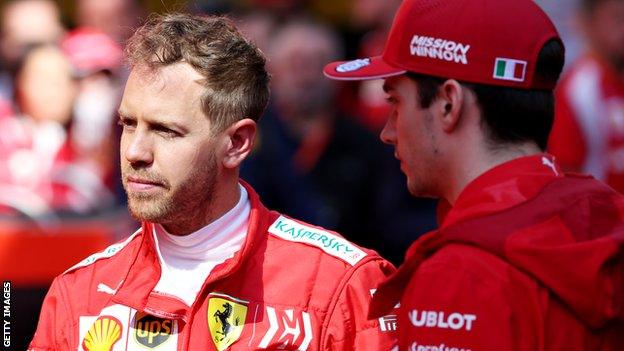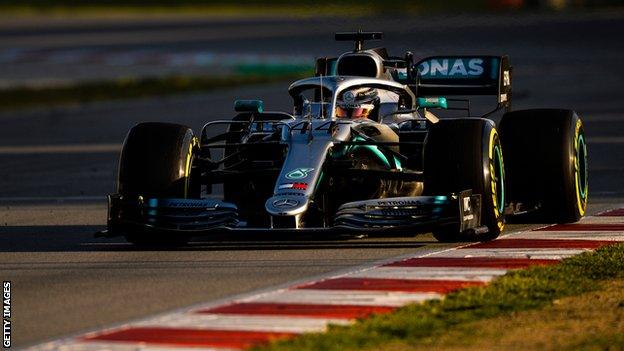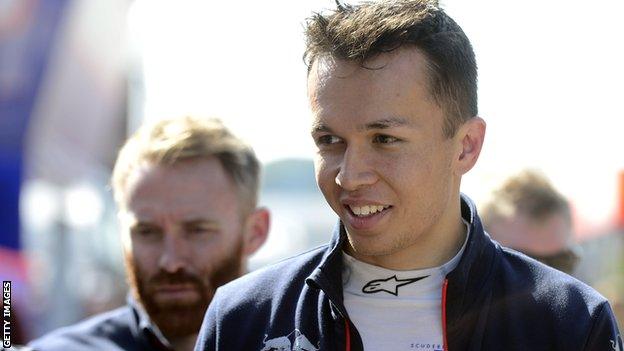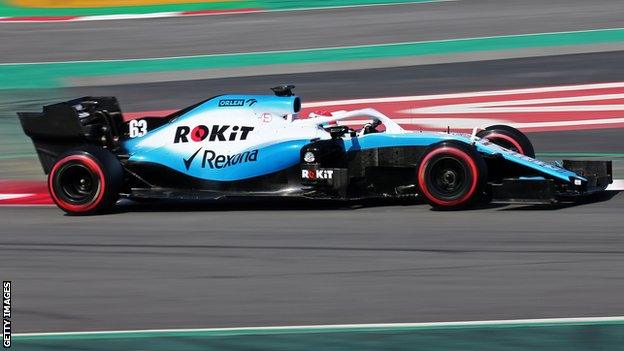Ferrari fastest, Mercedes 'not perfect', Verstappen 'optimistic' - F1 testing analysis
- Published
- comments

Sebastian Vettel won four drivers' titles in a row from 2010-2013
Ferrari left Barcelona on Friday having proved they had the fastest car over two weeks of pre-season testing.
Lewis Hamilton said it. His Mercedes team said it. Red Bull's Pierre Gasly said it. And the numbers said it, pretty much however you looked at them.
Hamilton might have said that performance in testing should be taken "with a pinch of salt". But he also said that he thought the gap between his Mercedes team and Ferrari was "potentially half a second, something like that".
That sounds a lot, in the context of Mercedes winning the past five world titles, but it's certainly the way it looked.
The lap times
Let's get the caveats out of the way. Everyone who knows anything about Formula 1 knows that pre-season testing times are an unreliable guide to actual performance.
There are just too many variables - such as fuel loads, engine modes and track conditions - to be able to compare lap times across teams and be confident of having an accurate picture.
On the list of the fastest lap times for each team throughout winter testing, Ferrari and Mercedes look closely matched:
Team (Driver) | Fastest lap time |
|---|---|
Ferrari (Vettel) | 1:16.221 |
Mercedes (Hamilton) | 1:16.224 |
Renault (Hulkenberg) | 1:16.843 |
Toro Rosso (Albon) | 1:16.882 |
McLaren (Sainz) | 1:16.913 |
Haas (Grosjean) | 1:17.076 |
Red Bull (Gasly) | 1:17.091 |
Alfa Romeo (Raikkonen) | 1:17.239 |
Racing Point (Stroll) | 1:17.556 |
Williams (Russell) | 1:18.130 |
But as you dig deeper, the gap extends.
To try to eliminate some of the margin of error in this, we can look at when the lap time was set on a particular run of laps, and calculate the minimum amount of fuel the car must have had on board. It still might have had more in it, but it's a start.
In addition, allowing for the differences between the five tyre compounds available - which vary from team to team but are in the region of 0.4-0.7secs per compound depending on the tyre - not everyone's fastest lap was their headline lap time.
What you might call the fuel-and-tyre-corrected list looks like this:
Team | Time |
|---|---|
Ferrari | one minute 15.720 seconds |
Mercedes | +0.504 |
Red Bull | +0.871 |
Haas | +0.921 |
Toro Rosso | +1.038 |
Renault | +1.123 |
McLaren | +1.195 |
Alfa | +1.395 |
Racing Point | +1.836 |
Williams | +2.41 |
Now we can see more where Hamilton's 0.5-second margin comes from.
And the same applies when looking at race pace. This is the best way to judge pre-season performance because it's the running in which the cars are likely to be in the most-similar specification.
There is still a little room for variability - especially on how hard the teams are running the engines, and a small degree of fuel load - but it is much reduced. And as conditions vary from day to day, it's hard to compare runs that don't happen contemporaneously.
But, as it happens, Hamilton's team-mate Valtteri Bottas and Ferrari's Charles Leclerc did race simulations at more or less the same time as each other on Thursday, and the Ferrari was demonstrably quicker - by 0.334secs a lap on average.
Taking the stints one by one, Leclerc was quicker by 0.491secs, 0.577secs and 0.118secs.
By the end of the 'race', Leclerc would have beaten Bottas by about 20 seconds.
Those race runs were not directly comparable, because Bottas did his first stint on the medium-compound C3 tyre, before switching to the harder C2s for his final two stints, while Leclerc used C2s throughout.
But, interestingly, Vettel did a race simulation on Friday, and like Bottas he used the C3s in the first stint. His times on the two stints he did before stopping with an electrical failure were almost identical to Leclerc's.
The differences between the two cars

Mercedes' Lewis Hamilton has won four of the past five drivers' championships
It would be unwise to draw too many firm conclusions from these times. Even if the performance seen is accurate, there is time for both teams to improve before the first race. And as one senior figure said: "Ferrari were quicker all last winter and then Mercedes went to Melbourne and blew them away."
But there is a potentially important difference between last year and this.
In 2018, although Ferrari topped the list of fastest times, Mercedes had done quicker race simulations, which is not the case this year.
On top of that, the Ferrari seems to be an easier car to work with and to drive than the Mercedes.
All test, Vettel and Leclerc were saying how well balanced the car was. It was quick right from the off, and remained so throughout the two weeks.
The Mercedes drivers, by contrast, were relatively struggling with their car. A dramatic aerodynamic upgrade for the second week improved it, but it was still not behaving as they wanted.
"From last week to this week," Bottas said, "definitely we have been able to improve the overall balance of the car through the speed range, overall grip, downforce and stability. But in all those areas we can still do better. It is not a perfect car yet."
It was also struggling with tyre usage. One of the reasons the Mercedes race simulations were slower than Ferrari's was that they were suffering more from 'graining' - where the surface tears, reducing grip.
Hamilton's conclusion was this: "Last year they arrived with a car working well but they have done even better this year. It's OK. We don't mind the challenge, it just means we have to work harder. I'm not worried or disappointed or anything. We have a hill to climb but we know how to do it."
But Ferrari team principal Mattia Binotto smelt a rat.
"I'm happy to know Hamilton believes we are faster and very strong," he said, "but I believe Mercedes will be very strong in Australia and it would be completely wrong to think we are faster than them. I am not expecting them to be behind us. I think they will be very, very close."
Are Mercedes likely to be as much as 0.5secs off Ferrari in Melbourne? Most would say not, given their strength. But the team themselves reckon the margin is somewhere in the region of 0.2-0.5secs, so it's intriguingly poised as the final preparations begin for the season-opening Australian Grand Prix from 15-17 March.
What about Red Bull?
Red Bull hoped their switch to Honda engines for this season would give them a step forward in 2019. They were not expecting to be title contenders, but they did believe they would be closer to the front.
Their testing performance is harder to read because they did not do any low-fuel, soft-tyre laps at all, and they did not complete any of their race simulations.
But Mercedes believe they and Red Bull are quite closely matched, and Max Verstappen sounded confident after completing his running.
"If we look to the longer runs, it looks all pretty promising," the Dutchman said. "I think we have a pretty good package. And also the engine seems to work really well. So I'm really happy about that.
"(Mercedes and Ferrari) are always going to be quick. I don't know where we will be but looking at the long-run pace, I'm optimistic."
What about the midfield?
The general belief was that the gap between the midfield teams and the front had reduced a little.
The times back this up. From being 1.5secs off the pace last year, the apparently quickest midfield team in testing - US-based Haas - were just under a second off this winter. And Toro Rosso, Renault and McLaren were all within just over 0.2secs of them.
Taking them individually, Haas had the fourth-fastest car last year, so there is no surprise they seem to be up there again, especially considering their close links with Ferrari, from whom they buy much of their car off the shelf.
Renault, after a low-key test achieving their primary aim of racking up lots of mileage, finally did some quick times on the final day. They look to have achieved their aim of moving closer to the front three teams, but will be looking for more once the season gets going.

Alexander Albon was one of a number of rookies who impressed during testing
Toro Rosso might seem to be surprisingly high up, given they finished ninth last season, but their car was genuinely quick on occasion last year, and this year they have gone down the Haas route and are buying as many parts as they can from parent team Red Bull.
That means the 2019 Toro Rosso is not far from being a 2018 Red Bull with a few changes for the new aerodynamic regulations. So, again, they ought to make a step forward. On the driver front, London-born Thai Alexander Albon made a strong impression and appears if anything to have been slightly quicker than his more experienced team-mate Daniil Kvyat.
McLaren, after a torrid 2018, had a much better winter and appear to have made progress.
The caveat to that is that Barcelona was one of their stronger circuits over the past two seasons - Fernando Alonso qualified seventh and eighth in 2017 and 2018 - so it is understandable that their main aim this winter has been to keep expectations in check, despite their improved performance and reliability compared to last winter.
Like Albon, British rookie Lando Norris showed strongly in testing, and was close to team-mate Carlos Sainz in pace.
"Some of the areas where we had quite a big weakness we've strengthened," Norris said. "I'm not saying it's perfect. But overall I think we have a better package to start the season with.
"There are still problems and things we suffer with. But I think we understand them and when we do change things the car is being affected in a positive way whereas last year we struggled a bit more to move forward."

Williams started testing two and a half days after the other teams and looked off the pace
Alfa Romeo - formerly Sauber - may look to have slipped back from the times but they are well within the margin of error for fuel loads, etc.
And Racing Point, formerly Force India, while looking slow, said from the outset that they were running a very basic car in testing and would have a major upgrade for the first race.
That leaves Williams, where the news does not look great at all. George Russell, the Formula 2 champion and another British rookie, set their quickest time, but he was under no illusions about where the team stood.
"I'd be lying if I said we were not the slowest at the moment," he said. "That is a reality."
Williams started testing two and a half days late and while they made up much of their mileage, Russell admitted: "We were a big step behind everybody else."
Williams say they have achieved some of their aims, in that the car lacks the handling vices of its predecessor and seems to respond to changes, which the 2018 car did not. Even so, it could be a long season for them.